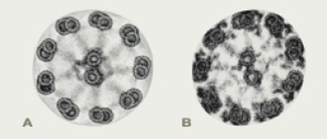
Abnormal Motor Proteins Cause Kartagener Syndrome An abnormal form of a motor protein called dynein causes Kartagener syndrome, a genetic disorder characterized by chronic sinus and lung infections. Biofilms form in the thick mucus that collects in the airways, and the resulting bacterial activities and inflammation damage tissues.
Affected men can produce sperm but are infertile. Some have become fathers after a doctor injects their sperm cells directly into eggs. Review FIGURE 4.21 and FIQURE 4.24, then explain how abnormal dynein could cause the observed effects.

FIGURE 4.24 Cross-section of the flagellum of a sperm cell from A a human male affected by Kartagener syndrome and B an unaffected male.
To explain: How abnormal dynein could cause Kartagener syndrome and male infertility.
Introduction: Kartagener syndrome is an autosomal recessive genetic condition characterized by ciliary motility disorder. Cilia are hair-like structures lining the mucus membranes of nose, lungs, and sinuses. In Kartagener syndrome, the cilia do not move properly and defects are found in dynein (a component of cilia) arms. This results in the abnormal morphology of sperm tails and bronchial cilia.
Explanation of Solution
Refer to Fig. 4.20, “How eukaryotic flagella and cilia move” in the textbook. Flagella and ciliary movements are provided by motor protein dynein attached to the nine microtubules arranged in a circle. Abnormality in dynein arms causes Kartagener syndrome. Refer to Fig. 4.24, “Cross-section of a sperm cell from A. a human male affected by Kartagener syndrome and B. an unaffected male” in the textbook. The lack of dynein arms results in the abnormal morphology of sperm tails and bronchial cilia causing lung infections, chronic sinus, and infertility. Men with Kartagener syndrome are infertile but they produce sperms. They are infertile because defected dynein would affect the movement of flagella and cilia. As a result, there would be abnormal sperm motility and it would not be able to swim normally for fertilization.
Want to see more full solutions like this?
Chapter 4 Solutions
Biology: The Unity and Diversity of Life (MindTap Course List)
- What is behavioral adaptarrow_forward22. Which of the following mutant proteins is expected to have a dominant negative effect when over- expressed in normal cells? a. mutant PI3-kinase that lacks the SH2 domain but retains the kinase function b. mutant Grb2 protein that cannot bind to RTK c. mutant RTK that lacks the extracellular domain d. mutant PDK that has the PH domain but lost the kinase function e. all of the abovearrow_forwardWhat is the label ?arrow_forward
- Can you described the image? Can you explain the question as well their answer and how to get to an answer to an problem like this?arrow_forwardglg 112 mid unit assignment Identifying melting processesarrow_forwardGive only the mode of inheritance consistent with all three pedigrees and only two reasons that support this, nothing more, (it shouldn't take too long)arrow_forward
- Oarrow_forwardDescribe the principle of homeostasis.arrow_forwardExplain how the hormones of the glands listed below travel around the body to target organs and tissues : Pituitary gland Hypothalamus Thyroid Parathyroid Adrenal Pineal Pancreas(islets of langerhans) Gonads (testes and ovaries) Placentaarrow_forward
 Biology: The Unity and Diversity of Life (MindTap...BiologyISBN:9781305073951Author:Cecie Starr, Ralph Taggart, Christine Evers, Lisa StarrPublisher:Cengage Learning
Biology: The Unity and Diversity of Life (MindTap...BiologyISBN:9781305073951Author:Cecie Starr, Ralph Taggart, Christine Evers, Lisa StarrPublisher:Cengage Learning Anatomy & PhysiologyBiologyISBN:9781938168130Author:Kelly A. Young, James A. Wise, Peter DeSaix, Dean H. Kruse, Brandon Poe, Eddie Johnson, Jody E. Johnson, Oksana Korol, J. Gordon Betts, Mark WomblePublisher:OpenStax College
Anatomy & PhysiologyBiologyISBN:9781938168130Author:Kelly A. Young, James A. Wise, Peter DeSaix, Dean H. Kruse, Brandon Poe, Eddie Johnson, Jody E. Johnson, Oksana Korol, J. Gordon Betts, Mark WomblePublisher:OpenStax College Human Physiology: From Cells to Systems (MindTap ...BiologyISBN:9781285866932Author:Lauralee SherwoodPublisher:Cengage Learning
Human Physiology: From Cells to Systems (MindTap ...BiologyISBN:9781285866932Author:Lauralee SherwoodPublisher:Cengage Learning Biology (MindTap Course List)BiologyISBN:9781337392938Author:Eldra Solomon, Charles Martin, Diana W. Martin, Linda R. BergPublisher:Cengage Learning
Biology (MindTap Course List)BiologyISBN:9781337392938Author:Eldra Solomon, Charles Martin, Diana W. Martin, Linda R. BergPublisher:Cengage Learning





